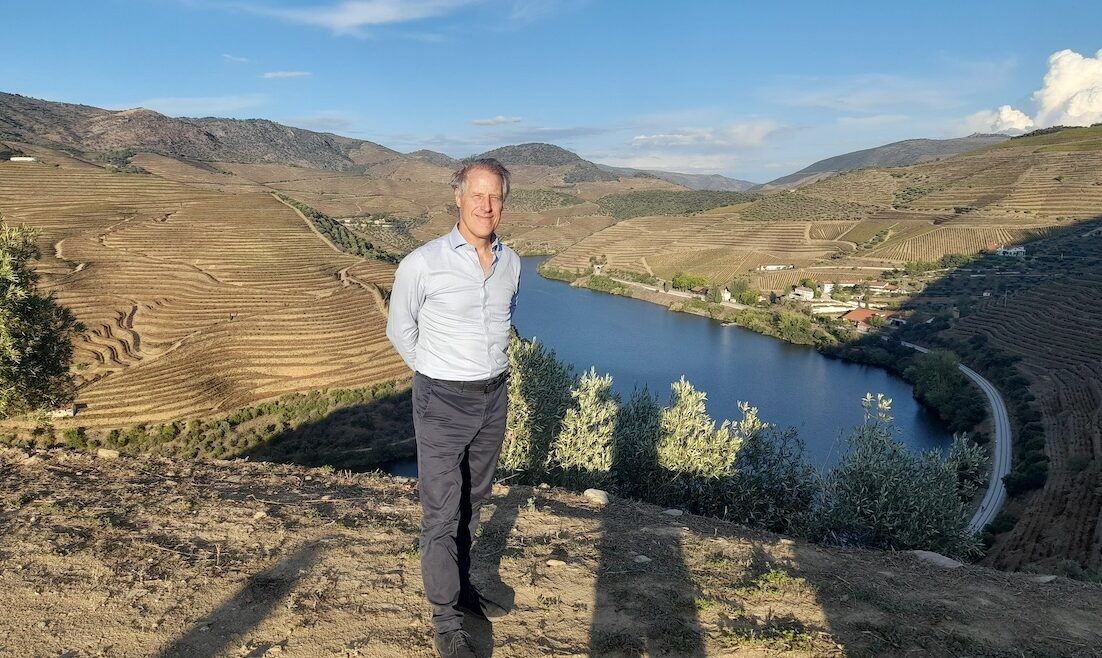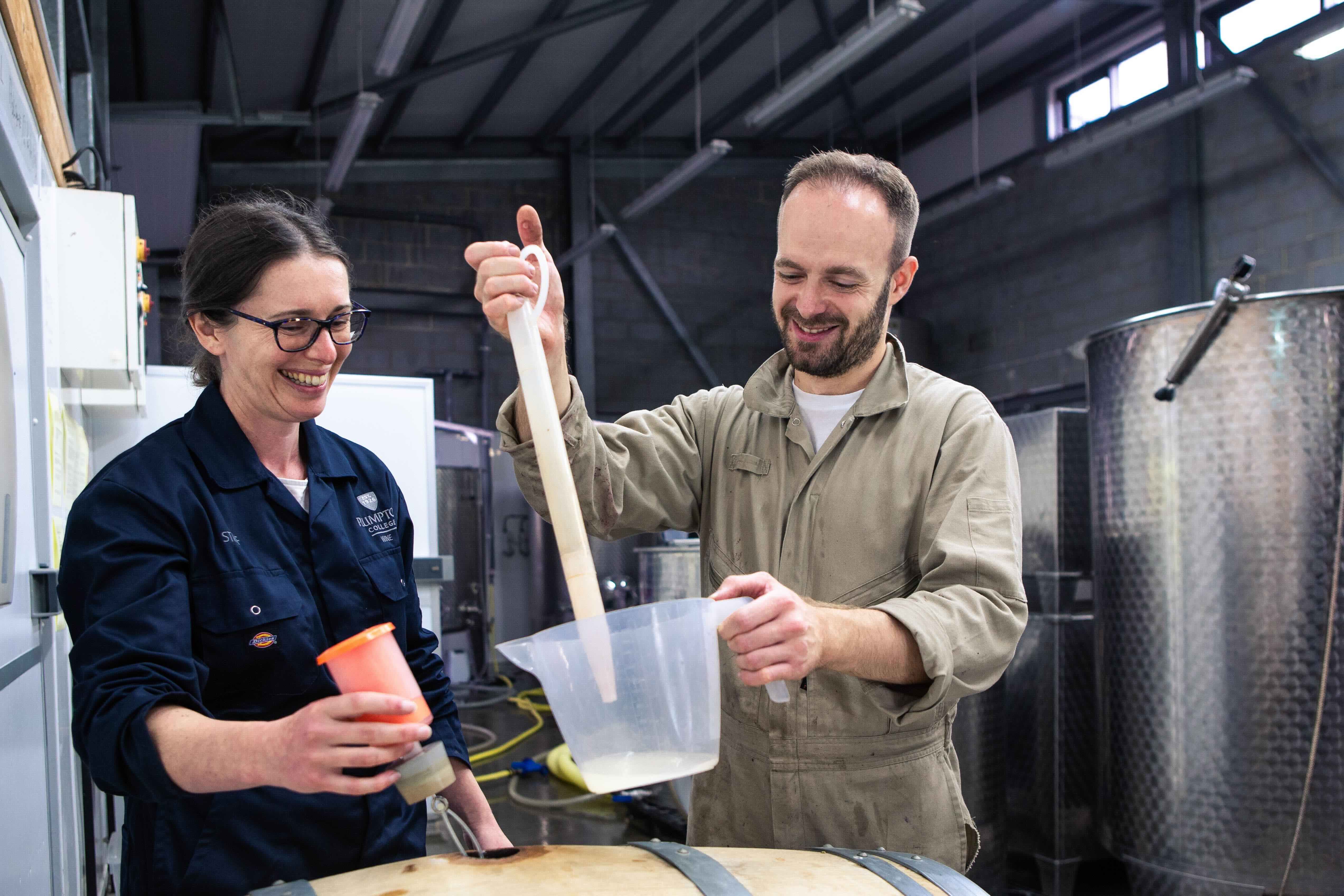“That’s where the future of the industry is….before it was 80% standard ports and 20% special category. We just make that top bit, but what it tells you is that top bit is the bit that’s in growth, and that is likely to continue,” says Fladgate Partnership managing director Adrian Bridge.
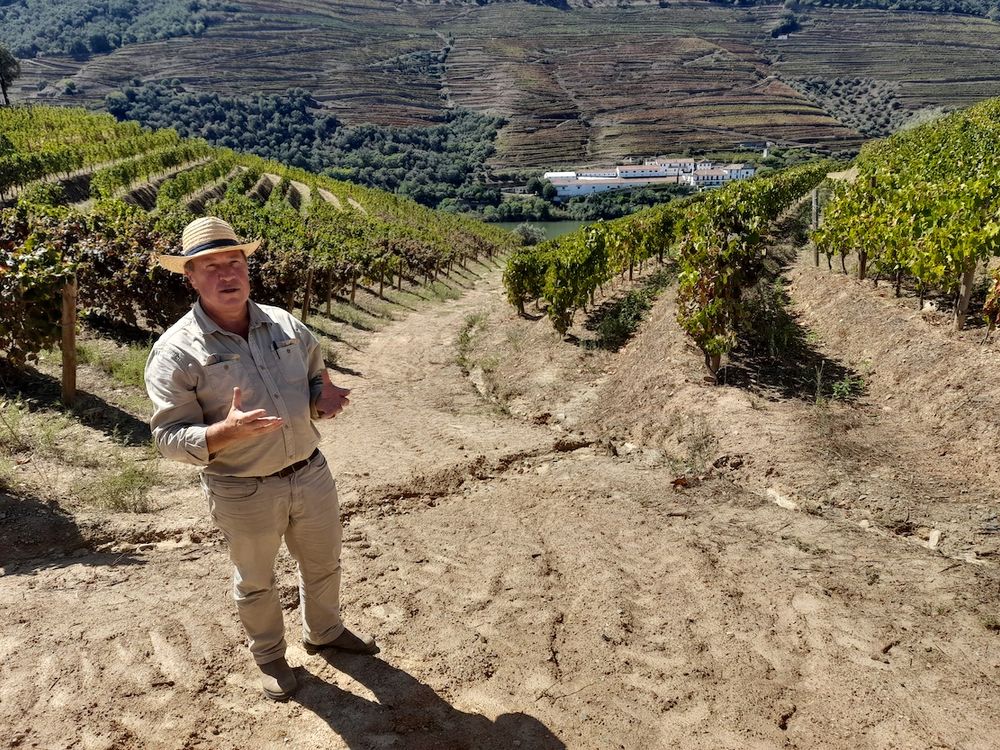
David Guimaraes, head technical director of the Fladgate Partnership at Roeda
Adrian Bridge, the Fladgate Partnership’s managing director, seems to relish problem-solving. After all, plenty of hurdles would have been put in his way at Sandhurst, the royal military academy where he won the sword of honour before joining his cavalry regiment. Under the former army officer’s meticulous auspices, the company, which consists of the port houses of Taylor’s, Fonseca and Croft, keeps going from strength to strength, with sales up 50% since 2018, thanks in no small part to the boom year of 2021. But as we drive from Porto to Vargellas, the magnificent Taylor’s estate in the Douro Valley, Bridge is musing over how to respond to the big duty increase on fortified wines that the UK government introduced a few weeks earlier on August 1.
This has put an extra £1.30 + VAT on a bottle of port of 20% abv, which may not affect uptake of vintage port but could impact on sales of mid-market versions, notably Late Bottled Vintage (LBV). “What we can do is cut the alcohol level in LBV to 19% as there’s a smaller duty increase for wines under 20%,” Bridge chuckled, referencing the duty hike of £0.97 + VAT for wines above 15% but under 20%.
LBV’s price point is important as the full new duty rise potentially lifts it from around the £16 mark to nearer £18. Although Bridge believes many UK retailers have enough stock that was duty-paid before August 1 to satisfy the surge in demand that always accompanies the run up to Christmas, the days of Taylor’s LBV being £16 RRP (sometimes promoted down to £10) are effectively over. But any means of keeping duty rises as low as possible are desirable for what is one of Fladgate’s cash cows.
For very large quantities of Taylor’s LBV are made by Fladgate, for whom it is their premium commercial wine. And demand for it, and other special category ports, is on the up, as Bridge is very much aware. “The interesting thing about this year is that we may get to the point where 25% of port sales in volume is special category but over 50% of the value is special category,” Bridge declared.
“That’s where the future of the industry is….before it was 80% standard ports and 20% special category. We just do that top bit, but what it tells you is that top bit is the bit that’s in growth, and that is likely to continue. Globally in most regions, the market for purely cheap alcohol is declining. People are looking for something that’s a bit more sophisticated. They’ll drink less but better quality. It doesn’t mean everyone is spending 50-60 quid on a bottle, but many between the £10-20 level. You can expect to see Taylor’s LBV retailing at £18 in the UK, sometimes promoted down to £13-14.”
Special category port is anything with a date on it – vintage, single quinta, LBV, Colheita, aged tawnies (10-40 year old) and crusted as well as dry white port and reserve ruby (such as Fonseca bin 27, which is hugely popular in the USA). Not qualifying for special category port status are white, standard ruby and three-year old tawny. This trio represent big volume sales.

Adrian Bridge, Vargellas behind him, September 2023
Two main wineries
Fladgate has two main wineries in the Douro Valley: Roeda in Pinhao, and Nogueira which is 25km further east, near Sao Joao de Pesquiera. Nogueira, which was bought in 1997 and completely refurbished, is dedicated to making special category ports.
“It’s really designed at Nogueita to be the top end…so we limit the quantity to about 120 tons per day that we take in. At Roeda, we’ve effectively got four wineries in one – traditional treading; cold fermenting and vinification of white or pink ports; some tanks making LBVs; and some big pumpover fermenters that will end up making ruby. They’re the buffer you need for those peak days when you’ve suddenly got too much coming in. They can take up to 200 tons per day at Roeda.”
Although Nogueira is only a working winery for about seven weeks of the year in autumn, it serves another very useful purpose. Its large surface area allows Fladgate to use it as a storage and maturation facility for its ports, particularly its tawnies. Bridge estimates that 20 million litres of stock is at Nogueira, with a similar amount elsewhere, including in the traditional maturation location of Vila Nova de Gaia in Porto.
“All these buildings here at Nogueira cover 5,000 square metres,” Bridge revealed during a tour of its many warehouses that house tens of thousands of barrels and scores of foudres. “We have some beautiful foudres, including a 14,000-litre ten-year old one. It’s pretty good temperature control here as its relatively cool being at 700 metres on top of a hill. So storing here is better than on city centre land as it’s not a good use of it. We still have some storage in Gaia at the visitor centre – mainly 20-year or older Tawny which you don’t move very often by definition – and also where our bottling operation is, on a 35-acre site close to the Yeatman [the 5-star Fladgate-owned hotel]. When ‘World of Wine’ was built, we moved a lot of stock to Nogueira.”
The wonderful World of Wine

World of Wine: opened in 2020 and was masterminded by Adrian Bridge
World of Wine, aka WOW, which opened in 2020, is surely the globe’s most comprehensive wine museum. Built by Fladgate at a cost of €105 million over 55,000 square metres where old port cellars were situated, it is nevertheless much more than that. Hailed as a cultural district, it has not just seven immersive museum experiences but also twelve restaurants and bars, shops, a wine school, a gallery for temporary exhibitions and even a chocolate factory. Bridge was the driving force behind WOW, as he was for the Yeatman, for whose completion he was awarded the ‘gold medal of the City,’ Porto’s highest civic honour.
“We liberated all that land to make World of Wine,” Bridge continued. “The climate difference here at Nogueira has not had a big effect. To simulate the conditions at Gaia, we have controlled humidity thanks to water jets that pump a small amount of water at very high pressure through a very, very tiny hole, and essentially create a cloud which is way more humid. Our re-use of barriques and smaller vessels is an experiment – you get higher rates of evaporation with 225, 470 and 600-litre vessels. We’re doing another experiment with the whisky people, buying their 470-litre waste casks, and cleaning out the whisky residue with Croft brandy, which we make about 100,000 cases of per year. We get them for just €100 – a new one costs €1500.”
The Yeatman and WOW embody Bridge’s belief in the importance of diversification for the Fladgate Partnership, which owns a top hotel in Pinhao and has plans for another in the valley. Although the company recently acquired another 200 hectares under vine, taking their total to around 750ha of vineyards, Bridge still pointed to the fact they are not in the top two of port producers.
“We are not that big – around 16.5% of value and about 13% of volume,” he said. “The biggest player, Porto Cruz, would be 30% volume, and Symington about 20%. We’re number three, then Sogrape is next one down on about 10%. We’re different in that Cruz and Symington would have about 2,500 farmers or more. We buy from 76 or 77 growers. All ours are professional farmers – that’s all they do. We don’t buy from the weekend farmers with half a hectare or a hectare who are the ones feeding the co-ops. It’s just not what we do. Either you’re going to buy from a co-op, or do it yourself and make better wine than you’ll get from the co-op. The better quality port we make from farmers, the more we pay them.”
The importance of foot-treading
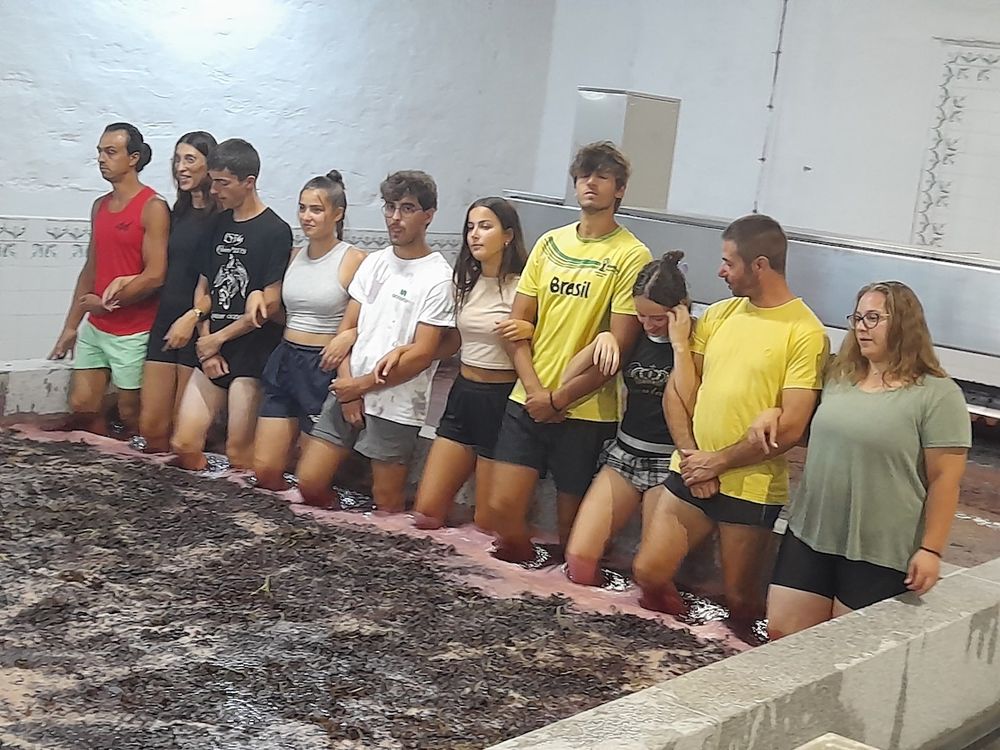
Foot-treaders at Vargellas, September 2023: making a crucial 1% difference
Fladgate’s other key point of difference is its continued embrace of foot-treading. “We still feel foot-treading for us makes the difference,” Bridge declared. “Others have 100% mechanised lagars. We probably do 60% of the foot-treading in the valley – we think it adds to complexity, gives better structure and makes better wine, even if it’s just 1% better.
“We’re one company – the reason we call ourself the Fladgate Partnership is that we’re not trying to say one company is more prominent than then other. Each port house has its own property, brand and stock. Essentially they have got the same quality ethic, and the way we approach the business is the same. I’m the CEO of all of them; David Guimaraes is the head technical director of all of them; but our tasting panels will have three people involved in each house’s blending – the head blender, the winemaker and the person for the house style. Some of our LBV will have had foot-treading.”
Guimaraes elaborated on the technical benefits of foot-treading during a rendezvous at Croft’s celebrated estate, Quinta da Roêda.
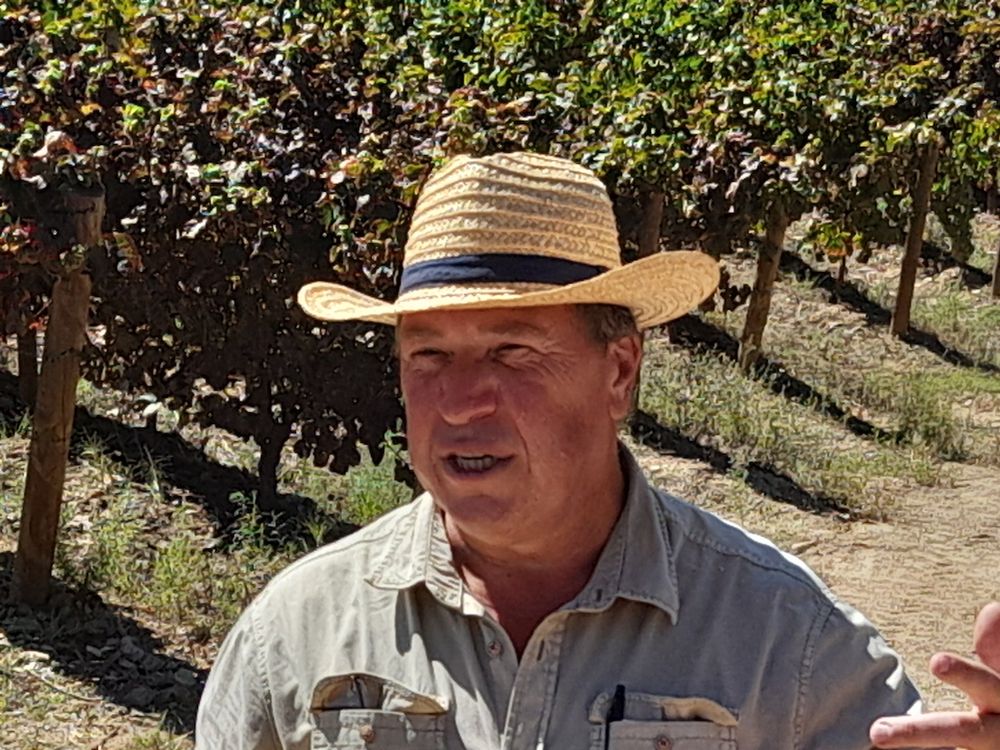
” The thermal dynamics of concrete give more structure and more depth of nose,” says Guimaraes
“Treading is very effective due to first treading after filling lagares,” he said. “The initial cut to open up the berry is so important to release the pip. Pre-Covid, we had treading all day as well in the evening, but I ventured into the first mechanical plungers in closed fermenters as a half-way house between mechanical and foot-treading. We didn’t want to change the style of our vintage port, and the alternative to treading was a big drop in quality. That’s when I introduced the first mechanical plungers in concrete rather than stainless steel. The thermal dynamics of concrete give more structure and more depth of nose.”
The harvest and foot-treading at Vargellas, where a large team of local Portuguese of varying ages pick by day and then tread for three hours in the evening, lasts around three weeks. Housed and fed at Vargellas for that period, it is hard physical endurance but a good arrangement for both parties. The pickers effectively get double pay and do not have the problem of having nothing to do in the evening in a remote location.
“We hire an entire community and provide good accommodation and food, so we don’t have the common problem of finding pickers,” Bridge explained. Treading with some of them for half an hour one evening, it was clear how well-motivated and happy they were in their work. They perform with the same military precision and commitment that the indefatigable Bridge runs the Fladgate Partnership.
Tasting a selection of Fladgate Partnership ports
Fonseca Bin 27
2,000 cases per year sold in UK (where RRP was £14.50 but now £16); biggest SKU seller in USA (closely followed by Taylor’s LBV), where it is sold in 16,000 shops; full-bodied reserve blend, also very popular in travel retail. 104 g/l residual sugar, TA 4.3 g/l
Fonseca Vintage Port 2003
Silky tannins with high quality brandy spirit; hugely complex, very long. 92 g/l RS, TA 4.45 g/l
Taylor’s 50-year old tawny
Stunningly complex (light colour no different to 30-year old). 158 g/l RS, TA 5.86 g/l; RRP £180
Taylor’s Quinta de Vargellas 2015
Beautifully integrated tannins; remarkable complexity and concentration from old vines that date back to 1908. 99g/l RS, TA4.36 g/l; RRP £35
Croft Vintage Port 2003
David Guimaraes’ favourite from the estate; the first to be made from foot-trodden fruit since 1963 (following Fladgate’s acquisition of Roeda in 2001). Very expressive, intense fruit; supremely elegant and so long. 92 g/l RS; TA 4.45 g/l
Croft LBV 2017
Very fresh with sweet fruit and peppermint notes. 101 g/l RS, TA 4.6 g/l; RRP £16
The wines of the Fladgate Partnership and imported and sold in the UK through Mentzendorff which is a commercial partner of The Buyer. To discover more about them click here.
